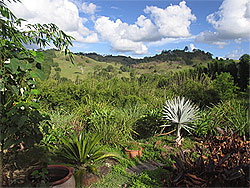
So we've been thinking a lot about what it takes to grow old gracefully. We know people who have, so it can be done. (Despite what Nora Ephron says. In an interview with Deborah Solomon for the New York Times, the author of I Feel Bad About My Neck responded to Solomon's comment "If nothing else, the aging process has furnished you with some good 'material' " with "Any catastrophe is good material for a writer." Don't break our hearts, Nora. We know it can be better than that.)
Our godmother, Rosemary, herself a glowing example of the beauty of old age, introduced us to Colette, who wrote the following passage:
"Sir,
You ask me to come and spend a week with you, which means I would be near my daughter, whom I adore. You who live with her know how rarely I see her, how much her presence delights me and I am touched that you should ask me to come and see her. All the same I am not going to accept your kind invitation, for the time being at any rate. The reason is that my pink cactus is probably going to flower. It's a very rare plant I've been given, and I'm told that in our climate it flowers only once every four years. Now, I am already a very old woman, and if I went away when my pink cactus is about to flower, I am certain I shouldn't see it flower again.
So I beg you, sir, to accept my sincere thanks and my regrets, together with my kind regards.
This note, signed 'Sidonie Colette, née Landoy,' was written my mother to one of my husbands, the second. A year later she died, at the age of seventy-seven.
Whenever I feel myself inferior to everything about me, threatened by my own mediocrity, frightened by the discovery that a muscle is losing its strength, a desire its power or a pain the keen edge of its bite, I can still hold up my head and say to myself: 'I am the daughter of the woman who wrote that letter—that letter and so many more that I have kept. This one tells me in ten lines that at the age of seventy-six she was planning journeys and undertaking them but that waiting for the possible bursting into bloom of a tropical flower held everything up and silenced even her heart, made for love ... Let me not forget that I am the daughter of a woman who bent her head, trembling, between the blades of a cactus, her wrinkled face full of ecstasy over the promise of a flower, a woman who herself never ceased to flower, untiringly, during three quarters of a century.' "
Here's our list.
Things to help us grow old gracefully:
Kiehl's sunscreen, maybe other kinds too (Vichy)
Colette's Earthly Paradise
beet, carrot, ginger juice (or any other combination)
bicycling
yoga
dancing
wine
subscriptions to Vogue
Regular river/pond/ocean swims
M. Minnaert (he wrote the book about light physics.)
vintage acid in your freezer
sherry
homemade ice cream
cool water
midnight hot tubs
toenail polish
fresh flowers
temporary tattoos
sisters
the mens (particularly their bums)
lots of music
dinner with friends (particularly at a long table out of doors)
candlelit baths
beer gardens
Marimekko
bulbs, and other flowers
basil seeds and other vegetables
small vases
nice textiles
books, lots of them
canes not walkers





